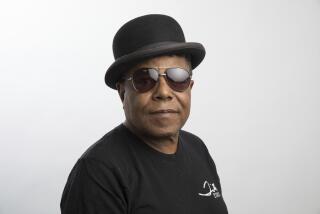Artist Charles Ray on his Whitney Biennial showing
Charles Ray is one of a dozen Los Angeles-based artists participating in the 2010 Whitney Biennial opening Thursday in New York, but he’s the only one marking his fifth appearance since 1989 in the important exhibition of contemporary American art.
Among his memorable entries were 1993’s “Firetruck,” a 12-by-47-foot replica of a toy fire truck “parked” outside the museum, and his “Family Romance,” which he described as “a nuclear family” -- four nude fiberglass figures holding hands now in the collection of New York’s Museum of Modern Art. Last spring, his 8-foot-tall sculpture of a boy dangling a frog, aptly titled “Boy With a Frog,” was unveiled at Punta della Dogana, outside Venice, Italy’s new contemporary art space.
Can you tell me about your Whitney piece? The Whitney said it’s a departure for you. Is that true?
I’m showing a group of flower drawings, which I don’t really show publicly that often, but I have in the past.
Why is that?
I’ve always been concerned with my sculpture. The drawings I do at night at home to relax. And for a long time I just gave them to friends or my wife and didn’t really show them. A few years ago I started showing them in a limited way and just decided to do this for the Whitney.
Why did you want to do that now? Now their place in the zeitgeist will be parsed.
I don’t think that far ahead. I thought it would be nice to do it, and [curator] Francesco Bonami gave me the opportunity to do it.
You knew him from Italy. Wasn’t he involved with the purchase of “Boy With a Frog”?
Not the purchase but the installation.
By the way, is it true that they still have a full-time guard over “Boy With a Frog” so that nobody snaps off the frog?
I don’t think they could snap the frog off. He’s holding onto it pretty tight. I think they’re more concerned with defacing it.
I think that’s a compliment, having a full-time guard for your sculpture when Venice has so many sculptures they’re not guarding.
Yeah, well, I think he could take care of himself.
Are you looking forward to the opening in New York?
I’m looking forward to the installing, not so much the opening. Openings are pretty crowded, a lot of hubbub and busy and everything.
You’re a biennial vet. Do you have a sense of how the biennial has evolved in your experience in terms of taste and influence?
I think it became a bigger and bigger, more unwieldy show, more and more inclusive. I guess that’s a good thing, but it can also be a hard thing for certain kinds of art -- for painting, for sculpture that needs a more contemplative space. It began to reflect a festival quality of a lot of biennials in art, which can be great, perhaps better for art that’s specifically made for that type of circus. Maybe more contemplative things may be overlooked or hard to look at, something that needs a little bit more room or time.
You had “Firetruck” outside the Whitney one year, right?
It was the same year I showed “Family Romance.” I had that upstairs and “Firetruck” downstairs. And the biennials I’ve been in I can’t really complain that they were too crowded. But it was a different time. For me space isn’t really a luxury. It’s a necessity. It’s a question of how work is embedded in a location.
I’ve read about your interest in solo sailing. Why solo sailing?
Because you don’t have to gather people together to go sailing. When you’re racing, you don’t have three or four other guys on the boat that you’re somehow fighting for control or dominance. Yet in single-handed racing, which I haven’t done as much in the last four years as I have in the past, it feels social because there are people out on the ocean doing what you’re doing. So you feel that you’re still in a group even though you’re alone in your boat and you might not see them until two days after the race is over.
And the name of your boat is C Squared? What does that mean?
It’s the speed of light squared, and it’s also my initial, and it’s also a pun on “sea.”
So what are you thinking about these days? What engages you?
I’m quietly pursuing work in the studio. It’s a glacial process. It’s almost like I’m trying to form myself, form my thoughts through my sculpture, form my relationship to the world through the work. When I make a figure, how the figure is made isn’t the most interesting thing to me. I see the figure as a manifold for sculptural events to occur.
I’m interested in the relationship of different parts of the figure and how they interact with each other. Sometimes in a sculpture it’s interesting to me what’s stylized and what’s natural and how those forms interrelate, as they interrelate in ourselves. There are parts of us we stylize and present to the world. And there are parts of us that we don’t stylize and are just natural. And they don’t just hang in a jarring way, hopefully, but there’s an interrelationship between them.
More to Read
The biggest entertainment stories
Get our big stories about Hollywood, film, television, music, arts, culture and more right in your inbox as soon as they publish.
You may occasionally receive promotional content from the Los Angeles Times.










